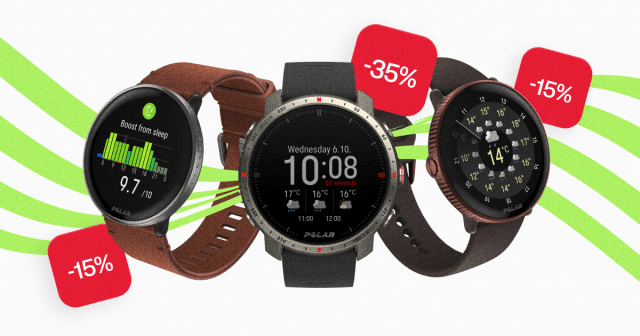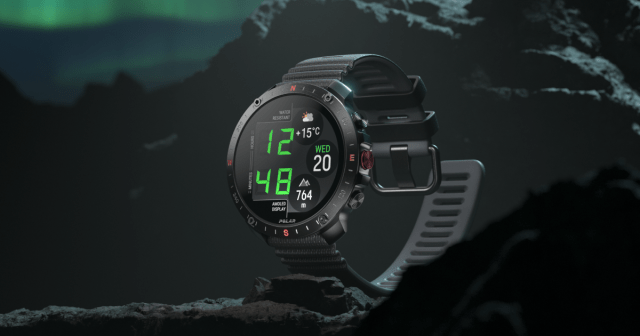Running tests are a popular way to check aerobic fitness, monitor progress, and even predict performance. For example, there’s the Cooper test, in which you must go all out for 12 minutes, and there’s the Yasso 800s speed workout that is designed to predict your marathon finishing time. Other tests, traditionally performed in a lab, measure oxygen intake and carbon dioxide output to accurately determine a runner’s VO2max values – the most common indicator of cardiovascular endurance.
When running gets serious and you’re chasing big goals, a running performance test should be part of your training plan. A test will help you optimize and personalize your workouts in the best possible way and make every session meaningful.
You don’t need to go through much trouble to plan a running test. Your watch offers the guidance you need to perform a test that will estimate your VO2max values, help you assess your fitness, and tweak your training. Designed for runners, the Polar Running Performance Test is a phenomenal tool to find out your unique training zones with accuracy and track progress.
Let’s see how. ?♀️ ?
What is The Running Performance Test?
The Polar Running Performance Test provides a convenient, reproducible, and cost-effective way to follow your progress, and get unique insights into your running performance. Use this test as a means of tracking your improvements in running performance and determine your training zones – heart rate, speed, and power. All you need is a pair of running shoes – and some grit!
Knowing your personal heart rate, speed, and power zones helps you fine-tune your training program so you always get the most of each session. This way, your running and your training will always be based on your current fitness level.
The Running Performance Test is available on several Polar products, like the latest additions to our family of running watches, Polar Pacer and Polar Pacer Pro, and flagship products like Polar Vantage V2 and Polar Grit X Pro.

When to take the Running Performance Test?
Testing your performance with a running test is a phenomenal way to start a new training cycle. If you’re aiming to race a 10k, complete a marathon, or simply improve your endurance, the results of test can inform your training program by pointing out, for example, the different heart rate zones you should reach in each training session.
The most accurate way to measure your VO2max is in a laboratory with expensive clinical equipment. You need to wear a mask and a heart rate monitor hooked up to a few machines that will measure your oxygen intake and heart rate. While looking like a robot from a sci-fi movie, you need to run on a treadmill at a progressive pace until you’re exhausted – typically when you reach your maximum heart rate after twenty minutes or so. Depending on your concentration of oxygen and carbon dioxide being inhaled and exhaled, your VO2max will be scored.
Since these type of tests can be expensive and not realistic for most people, only elite and professional athletes have access to it regularly enough to monitor their performance and adjust their individual training zones as their training cycle progresses. Fortunately, for fitness enthusiasts, technology has made available other options to calculate the efficiency of your cardiovascular system. One of those options is the Running Performance Test – a suitable option for the dedicated runner.
Track your progress with the Running Performance Test
If you want to use Running Performance Test to track your progress and help you choose the right training intensities, you should repeat the maximal test every three months to ensure that your training zones are always up to date. If you want to follow your progress more closely, you can repeat the submaximal version of test (more on this below) as often as you wish in between the maximal tests.
Repeat the maximal test every three months or so to ensure that your training zones are always up to date.
How does the Running Performance Test work?
You can do the Running Performance Test anywhere you want, but we recommend you run on a track, if possible, or on a long, flat path where you can continuously run without interruptions like traffic lights, or hills that might make your heart rate raise too fast. Wherever you run, you don’t want to stop running during the test.

Like a running test in a lab, the Running Performance Test is uncomplicated. All you need to is to follow a target speed that increases gradually throughout the test.
The test starts with a warm up. Run a few minutes at an easy pace to get your body started. After warming up, the real test starts. From the initial target pace, the watch will indicate a progressively faster pace. The initial target speed is set to 6 km/h (10 min/km), a walking pace for most people, to allow runners of all abilities to take the test. Advanced runners may increase this initial speed up to 15 km/h (4 min/km) in the test settings.
Let Your Watch Guide You
Keep your pace as close to what the watch indicates. You’ll notice how your run gets faster and harder, and your heart beats faster. The rate of change for the target speed remains constant throughout the test – 1 km/h (60 min/km) for every 100 seconds – no matter what speed you begin with.
There’s not a set time or distance that you need to run to complete the test as long as you’re run for six minutes. If you can’t go all the way out, you can finish the test when reach 85% of your maximum heart rate. In this case, you’d have completed a submaximal test.
However, you can continue the test until exhaustion to determine your running performance with the highest possible accuracy and update your maximum heart rate. Run a little bit harder and faster until you’re exhausted and can’t keep it up any more. At that time, you should have reached your maximum heart rate.
Some practical tips before you take the running performance test
There’s no way around it. The Running Performance Test is physically demanding if you want to get the most accurate results. After all, this test calculates your VO2max based on the maximal aerobic speed that it measures during the test. In other words, you need to run as fast as you can until exhaustion.
For reliable results, follow these tips
- You should prepare for the test as you would prepare for a race.
- Avoid heavy training for 48 hours before the test and follow your sleep schedule.
- Fuel with carbs within 24 hours before the test, but avoid eating three hours before the test.
- If you run outdoors, consider weather conditions, too. Warm weather, for example, can play a crucial role and impact the results.
- Get familiar with the test and the guidance your Polar watch provides. Go for a practice run a few days before.
- If you are ill, suffering from an injury, or you aren’t ready to give it your best shot, you should postpone the test – the lab is always with you, on your wrist, so choose the best moment for the test.
Not ready to go all out? The beauty of Running Performance Test lies in the fact that you can use it in two ways: you can go all-out or you can take it easy. In other words, you can take the maximal or submaximal test. The first is very accurate, but very tough, too. The latter, however, is less accurate, but it’s also less exhausting.
Get Results: VO2 Max and Maximum Heart Rate

When you complete the Running Performance Yest, you’ll get two very important figures: 1) Your VO2max, and 2) Your maximum heart rate.
1. V02max
Simply put, VO2max refers to the maximum amount of oxygen a person can use during exercise, how many milliliters of oxygen is being used by each kilogram of your body weight.
This measurement describes your current cardiovascular fitness. Since muscles need oxygen to move over the prolong periods required for running and other endurance sports, improving this metric can make you healthier and boost your overall performance.
For beginners and experienced exercisers alike, a higher VO2 max can make workouts feel easier, lower your 5K or 10K times by a significant margin, and help you go longer without tiring as quickly during races or difficult workouts.
VO2max is a good indicator of how your fitness improves over time.
2. Maximum Heart Rate
While VO2max shows your improvement over time, estimating your maximum heart rate will inform your workouts and the pace you need to hit in each session to maximize each run and its benefits.
When you know you maximum heart rate, you also know your heart rate training zones because they are just percentages of your maximum heart rate. And once you know your heart rate zones, planning your running sessions is as easy as following the speed limit signs on the roadway.
Variety is key to becoming a better a runner – don’t get stuck running at the same pace and intensity. Dial in your heart rate zones with the Running Performance Test and crate a routine where you train in all five zones.
Run on Your Own Level
Ready to dial in your training program with the Running Performance Test? Now that you know the benefits of making a running test part of your plan, you only need to lace up your shoes and break a sweat.
What the video below for more detailed instructions and tips.
If you liked this post, don’t forget to share so that others can find it, too.
Or give it a thumbs up!
I like this article
Please note that the information provided in the Polar Blog articles cannot replace individual advice from health professionals. Please consult your physician before starting a new fitness program.




